Difference between revisions of "Energy Storage 101/Drivers and Big Picture"
| (11 intermediate revisions by the same user not shown) | |||
| Line 1: | Line 1: | ||
{{DISPLAYTITLE: The State of Energy Storage: {{SUBPAGENAME}}}} | {{DISPLAYTITLE: The State of Energy Storage: {{SUBPAGENAME}}}} | ||
| Line 6: | Line 4: | ||
==Decreases in Technology Costs== | ==Decreases in Technology Costs== | ||
Massive research and development investment and manufacturing scale-up has driven costs down for lithium ion battery storage. This was initially driven by the consumer electronics market (e.g. cell phones and laptops) and more recently accelerated by the electric vehicle market. There has been an almost 90% reduction in $/kWh cost in the last decade and lithium ion costs are expected to continue to decrease with additional manufacturing improvements and economies of scale. Solar and wind technology cost reductions are also driving deployment of energy storage for hybrid applications. | Massive research and development investment and manufacturing scale-up has driven costs down for lithium ion battery storage. This was initially driven by the consumer electronics market (e.g. cell phones and laptops) and more recently accelerated by the electric vehicle market. There has been an almost 90% reduction in $/kWh cost in the last decade and lithium ion costs are expected to continue to decrease with additional manufacturing improvements and economies of scale. Solar and wind technology cost reductions are also driving deployment of energy storage for hybrid applications. | ||
Bloomberg New Energy Finance projects 2030 lithium ion pack costs at $62/kWh based on observed prices and an 18% learning rate. | Bloomberg New Energy Finance projects 2030 lithium ion pack costs at $62/kWh based on observed prices and an 18% learning rate.<ref>BloombergNEF: "[https://about.bnef.com/blog/behind-scenes-take-lithium-ion-battery-prices/ A Behind the Scenes Take on Lithium-ion Battery Prices]"</ref> | ||
[[File:EPRI ES Cost Trends.png|none|thumb|650px|Over 40% cost reduction projected for lithium ion systems by 2030.<ref>"[https://www.epri.com/research/products/000000003002020048 EPRI Battery Energy Storage Lifecyle Cost Assessment Summary: 2020]"</ref>]] | |||
==Increasing Renewable Generation== | ==Increasing Renewable Generation== | ||
Solar photovoltaic (PV) is driving midday over generation and increased evening ramping requirements which provides a value stream for flexible energy storage. As more solar comes online, the effective net load in the middle of the day decreases. | Solar photovoltaic (PV) is driving midday over generation and increased evening ramping requirements which provides a value stream for flexible energy storage. As more solar comes online, the effective net load in the middle of the day decreases. Similarly, wind energy is also driving flexibility needs. | ||
[[File:Caiso_Duck_Curve_Ramping.png|none|thumb|650px|Source: [https://www.caiso.com/Documents/FlexibleResourcesHelpRenewables_FastFacts.pdf | [[File:Caiso_Duck_Curve_Ramping.png|none|thumb|650px|Source: CAISO - "What the duck curve tells us about managing a green grid"<ref>California Independent System Operator (CAISO): "[https://www.caiso.com/Documents/FlexibleResourcesHelpRenewables_FastFacts.pdf What the duck curve tells us about managing a green grid]"</ref>]] | ||
==Evolving Utility Needs== | ==Evolving Utility Needs== | ||
| Line 29: | Line 27: | ||
===U.S. Federal Policy=== | ===U.S. Federal Policy=== | ||
In the last decade there has been a shift in policy towards energy storage. At the federal level, FERC has issued several orders as outline below to support energy storage in markets. | In the last decade there has been a shift in policy towards energy storage. At the federal level, FERC has issued several orders as outline below to support energy storage in markets. | ||
[[File:Us_Fed_Regulation.png|none|thumb|800px|Overview of recent energy storage related Federal Energy Regulatory Commission (FERC) orders]] | [[File:Us_Fed_Regulation.png|none|thumb|800px|Overview of recent energy storage related Federal Energy Regulatory Commission (FERC) orders. <br> | ||
<sup>1</sup>Lawrence Berkeley National Lab, Hybrid Power Plants: Status of Installed and Proposed Projects.<ref>Lawrence Berkeley National Lab, Hybrid Power Plants: Status of Installed and Proposed Projects</ref>]] | |||
===U.S. State Policy=== | ===U.S. State Policy=== | ||
At the state level, there has been an expanding number of policies to address energy storage in various ways. | At the state level, there has been an expanding number of policies to address energy storage in various ways. | ||
'''Procurement Targets | *'''Clean Energy Goals''': Carbon-free, renewable portfolio standards, and net-zero goals. | ||
*'''Procurement Targets''': Regulators or legislators set procurement goals and mandates requiring utilities to directly procure or contract storage. | |||
*'''Resource Plans''': State agencies or regulators fund studies or direct utilities to create an energy plan with consideration of storage. Many utilities and states included storage in their resource plan even if not directed to by regulators (not shown on the figure). | |||
*'''Incentives''': Legislators created economic incentives (e.g., rebates or subsidies) for deploying storage. | |||
[[File:Es101driver10.png|none|thumb|800px|States are taking varying approaches to energy storage deployment.<ref>Pacific Northwest National Laboratory (PNNL): [https://energystorage.pnnl.gov/regulatoryactivities.asp Energy Storage Policy Database]</ref>]] | |||
[[File:Es101driver10.png|none|thumb|800px|States are taking varying approaches | |||
=Current Status and Future Outlook= | =Current Status and Future Outlook= | ||
By the end of 2018, battery energy storage had been deployed in nearly every region of the U.S. under a variety of ownership models. IPPs owned most of the power capacity, providing market services for ISOs like PJM and ERCOT. Conversely, IOUs owned most of the energy capacity, serving needs such as renewable firming and load shifting in places like California and New England. <ref>Helman U, Kaun B, and Stekli J (2020) [https://www.frontiersin.org/articles/10.3389/fenrg.2020.539752/full Development of Long-Duration Energy Storage Projects in Electric Power Systems in the United States: A Survey of Factors Which Are Shaping the Market] | By the end of 2018, battery energy storage had been deployed in nearly every region of the U.S. under a variety of ownership models. IPPs owned most of the power capacity, providing market services for ISOs like PJM and ERCOT. Conversely, IOUs owned most of the energy capacity, serving needs such as renewable firming and load shifting in places like California and New England. <ref>Helman U, Kaun B, and Stekli J (2020) "[https://www.frontiersin.org/articles/10.3389/fenrg.2020.539752/full Development of Long-Duration Energy Storage Projects in Electric Power Systems in the United States: A Survey of Factors Which Are Shaping the Market]"</ref> | ||
==Energy Storage Deployment Trends== | ==Energy Storage Deployment Trends== | ||
Since 2018, the size and duration of projects has generally increased. Announcements for new battery energy storage sites planned over the next 2-3 years have grown — now, individual sites may host hundreds of megawatts and nearly a gigawatt-hour each. | Since 2018, the size and duration of projects has generally increased. Announcements for new battery energy storage sites planned over the next 2-3 years have grown — now, individual sites may host hundreds of megawatts and nearly a gigawatt-hour each. | ||
==Deployments by Technology== | ==Deployments by Technology== | ||
[[File:Global_ES_by_technology.PNG|none|thumb|900px|A breakdown of global energy storage installations by technology. Data Source: CNESA<ref>China Energy Storage Alliance | [[File:Global_ES_by_technology.PNG|none|thumb|900px|A breakdown of global energy storage installations by technology. Data Source: CNESA<ref>China Energy Storage Alliance (CNESA): "[https://en.cnesa.org/latest-news/2020/9/26/cnesa-global-energy-storage-market-analysis2020q2-summary Global Energy Storage Market Analysis—2020.Q2 (Summary)]"</ref>]] | ||
= | =References= | ||
<references /> | |||
Latest revision as of 14:49, 19 November 2021
Drivers for Energy Storage
Decreases in Technology Costs
Massive research and development investment and manufacturing scale-up has driven costs down for lithium ion battery storage. This was initially driven by the consumer electronics market (e.g. cell phones and laptops) and more recently accelerated by the electric vehicle market. There has been an almost 90% reduction in $/kWh cost in the last decade and lithium ion costs are expected to continue to decrease with additional manufacturing improvements and economies of scale. Solar and wind technology cost reductions are also driving deployment of energy storage for hybrid applications. Bloomberg New Energy Finance projects 2030 lithium ion pack costs at $62/kWh based on observed prices and an 18% learning rate.[1]
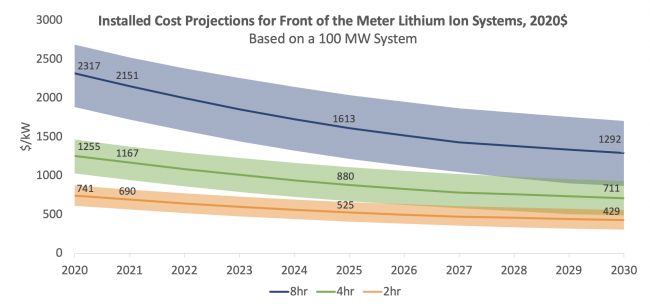
Increasing Renewable Generation
Solar photovoltaic (PV) is driving midday over generation and increased evening ramping requirements which provides a value stream for flexible energy storage. As more solar comes online, the effective net load in the middle of the day decreases. Similarly, wind energy is also driving flexibility needs.
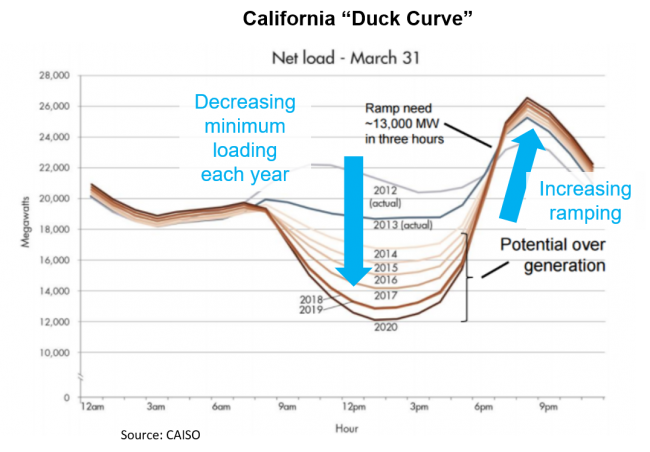
Evolving Utility Needs
- The grid infrastructure (generation, transmission, and distribution) is sized for infrequent peak needs and therefore most assets are under-utilized most of the time. Energy storage can support peak load reduction to provide significant cost reduction opportunity to electricity customers.
- Utility asset infrastructure is aging and peak load reduction may extend asset life and offer opportunity to consider investment in new technologies.
- Peaker plants are only used a fraction of hours per year and energy storage is being considered as peaking capacity in generation planning. Battery storage is already being deployed for this application and as costs decrease they may be cost competitive with combustion turbines in the next decade. When accounting for operational benefits, the crossover point on cost may be sooner.
Increasing Utility Customer Choice and Engagement
Customers (residential, commercial, industrial) are considering energy storage for:
- Bill savings
- Increased energy independence
- Renewable energy goals
- Backup premise or critical loads
Policy and Regulatory Changes
U.S. Federal Policy
In the last decade there has been a shift in policy towards energy storage. At the federal level, FERC has issued several orders as outline below to support energy storage in markets.
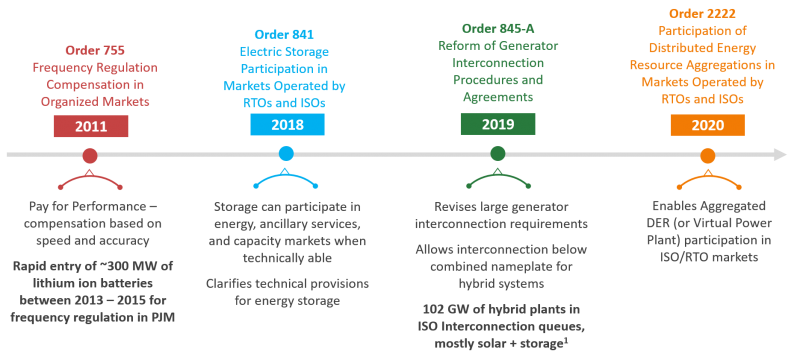
1Lawrence Berkeley National Lab, Hybrid Power Plants: Status of Installed and Proposed Projects.[4]
U.S. State Policy
At the state level, there has been an expanding number of policies to address energy storage in various ways.
- Clean Energy Goals: Carbon-free, renewable portfolio standards, and net-zero goals.
- Procurement Targets: Regulators or legislators set procurement goals and mandates requiring utilities to directly procure or contract storage.
- Resource Plans: State agencies or regulators fund studies or direct utilities to create an energy plan with consideration of storage. Many utilities and states included storage in their resource plan even if not directed to by regulators (not shown on the figure).
- Incentives: Legislators created economic incentives (e.g., rebates or subsidies) for deploying storage.
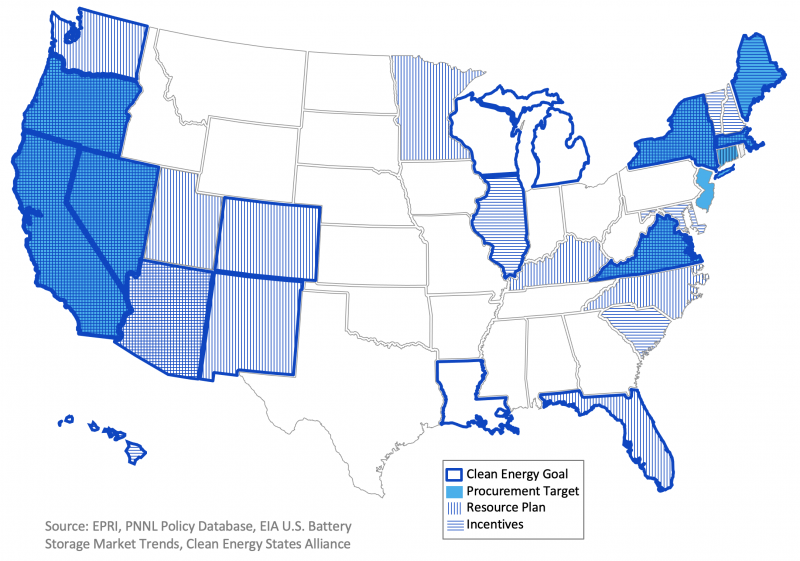
Current Status and Future Outlook
By the end of 2018, battery energy storage had been deployed in nearly every region of the U.S. under a variety of ownership models. IPPs owned most of the power capacity, providing market services for ISOs like PJM and ERCOT. Conversely, IOUs owned most of the energy capacity, serving needs such as renewable firming and load shifting in places like California and New England. [6]
Energy Storage Deployment Trends
Since 2018, the size and duration of projects has generally increased. Announcements for new battery energy storage sites planned over the next 2-3 years have grown — now, individual sites may host hundreds of megawatts and nearly a gigawatt-hour each.
Deployments by Technology
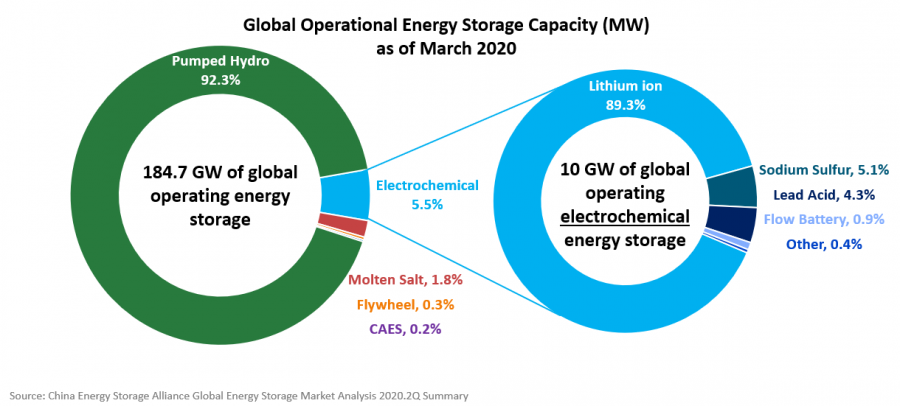
References
- ↑ BloombergNEF: "A Behind the Scenes Take on Lithium-ion Battery Prices"
- ↑ "EPRI Battery Energy Storage Lifecyle Cost Assessment Summary: 2020"
- ↑ California Independent System Operator (CAISO): "What the duck curve tells us about managing a green grid"
- ↑ Lawrence Berkeley National Lab, Hybrid Power Plants: Status of Installed and Proposed Projects
- ↑ Pacific Northwest National Laboratory (PNNL): Energy Storage Policy Database
- ↑ Helman U, Kaun B, and Stekli J (2020) "Development of Long-Duration Energy Storage Projects in Electric Power Systems in the United States: A Survey of Factors Which Are Shaping the Market"
- ↑ China Energy Storage Alliance (CNESA): "Global Energy Storage Market Analysis—2020.Q2 (Summary)"